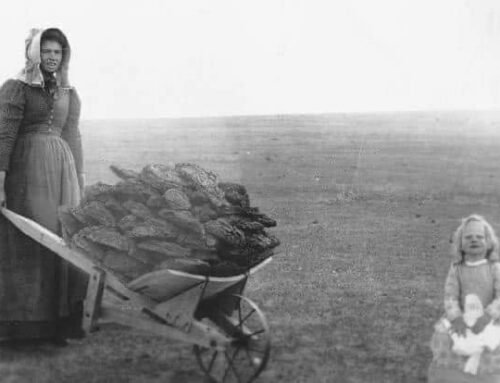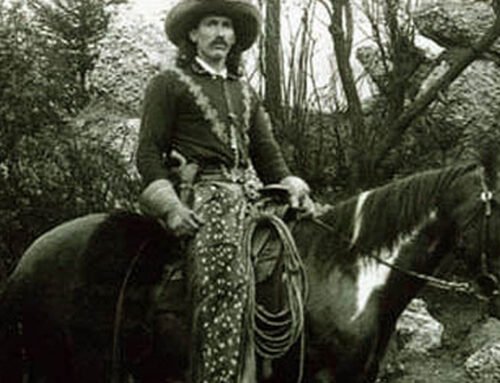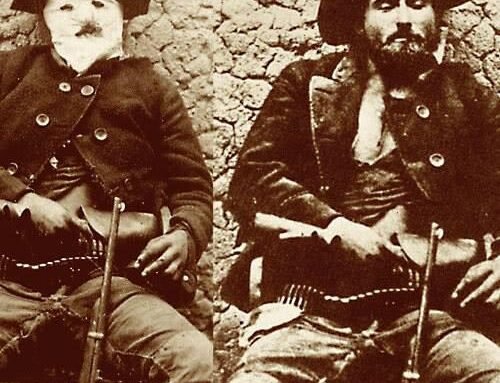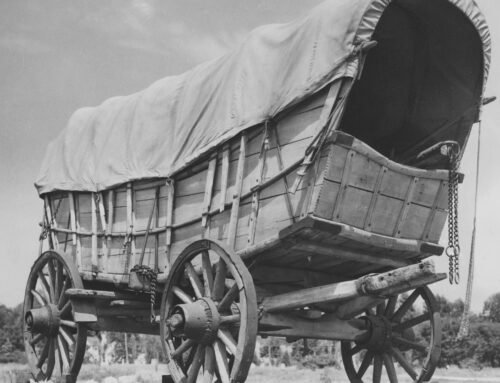Old West lariats
By western author Nick Brumby
“When you reach the end of your rope, tie a knot in it and hang on.”
—Cowboy wisdom
 The lariat is like a cowboy’s Swiss army knife – a seemingly simple tool with a million different uses. No self-respecting cowboy would be caught out on the range without a strong rope near to hand.
The lariat is like a cowboy’s Swiss army knife – a seemingly simple tool with a million different uses. No self-respecting cowboy would be caught out on the range without a strong rope near to hand.
A lasso or lariat (also called reata and la reata in Mexico) is a loop of rope designed as a restraint to be thrown around a target and tightened when pulled. Technically the correct term for the rope itself is lariat, and the word lasso is referred to how it is used.
Cowboys themselves aren’t so fussy – they call it a lasso or a lariat, or sometimes just simply a rope!
A lariat is made from stiff rope so that the noose stays open when it is thrown. It also means a cowboy can easily release the noose from horseback and free the cattle because the rope is stiff enough to be pushed a little.
A high-quality lariat is weighted for better handling. The rope passes through a small reinforced loop at one end, called a Honda or Hondo, to form a loop. The other end is sometimes tied simply in a small, tight, overhand knot to prevent fraying.
Initially, lariats were usually made of horsehair or cowhide. Hair ropes were often favored as they were lighter than cowhide. However they often did not age well, and were prone to kinks. Cowhide ropes were better but were quite heavy and clunky, and could easily break once a few strands wore out. While these types of ropes are now outdated, it is not uncommon for older, more traditional ropers to prefer to use these classic types of rope.
 The Spanish, Mexicans and Native Americans also made ropes out of rawhide. They would stretch a steer hide on a level place and let it dry. Then they would cut a strand in a circle about a 1/4-inch thick on a bevel, the flesh side wider than the top side since it was much stronger.
The Spanish, Mexicans and Native Americans also made ropes out of rawhide. They would stretch a steer hide on a level place and let it dry. Then they would cut a strand in a circle about a 1/4-inch thick on a bevel, the flesh side wider than the top side since it was much stronger.
They continued cutting around until they got the strand to the right length, then they would cut three more to match. Fastening one end on something solid, they would scrape the hair off with a sharp knife. Then they plaited the strands together.
The rawhide rope was the best throw rope, but not the strongest. A man could throw them against the wind. It was stiff when new, and he would tie it between two trees and leave it stretched for a few days. Only then would it behave the way he wanted it to. In cold weather some cowboys took their rope to bed to keep it supple for the next day’s work.
 Many modern lariats are made of stiff nylon, polyester, or Hemp. These materials have proven to be substantially more durable and useful than both hair and cowhide ropes. For those who prefer a more classic type of rope that pays tribute to the lasso’s roots, the Maguey lariat is often favored. Maguey rope is made from Agave strands, and the finished product is smooth and strong, known for its stiffness, which is great for holding a good noose.
Many modern lariats are made of stiff nylon, polyester, or Hemp. These materials have proven to be substantially more durable and useful than both hair and cowhide ropes. For those who prefer a more classic type of rope that pays tribute to the lasso’s roots, the Maguey lariat is often favored. Maguey rope is made from Agave strands, and the finished product is smooth and strong, known for its stiffness, which is great for holding a good noose.
While lariats are mostly associated with America’s western Frontier, there is evidence they have been used throughout history. Images exist of ancient Egyptian Pharaohs using lariats in 1280BC. Lassos are also mentioned in the Greek Histories of Herodotus.
In addition to this, lariats were use by the Huns in Asia around 370AD, while the Persians considered the lariat a critical tool in battle.
 The Spaniards who brought the first horses to America introduced roping in 1519. Native Americans used them in battle against the Spanish conquistadors, and quickly caught on to using them from horseback. They are still used by the Sami people and Finns in reindeer herding, while in Mongolia, a variant of the lariat called an ‘uurga’ is used, (this is a rope loop at the end of a long pole).
The Spaniards who brought the first horses to America introduced roping in 1519. Native Americans used them in battle against the Spanish conquistadors, and quickly caught on to using them from horseback. They are still used by the Sami people and Finns in reindeer herding, while in Mongolia, a variant of the lariat called an ‘uurga’ is used, (this is a rope loop at the end of a long pole).
In fact, African slaves in Mexico were among the first individuals to use lariats to round up loose cattle from horseback, becoming some of the very first ‘cowboys’.
Beside cow work, an Old West cowboy had endless uses for his lariat. It could pull cattle out of mud holes, rescue a drowning cowboy, or help free a chuck wagon stuck in a muddy rut.

It could be used to haul a load of wood to the campfire or help put out a grass fire by pulling a ‘drag’—a deliberately killed, bloodied steer.
It could save a cowboy on foot from an angry steer, bullwhip a snake to death as far as the rope would reach, and pull soggy women and children out of well holes and save cowboys suspended over cliffs.
It’s not every cowboy who can throw a lariat – there is an art to it. The first step in throwing a lariat is to have it prepared. Take the rope and curl it into neat loops. Take the hondo and thread the rope through to form a hoop.
Bring your hand holding the hoop forward at stomach level. Swing it over your head and find your target. If it is a live animal, wait until you can see between the ears or horns. Then bring your swinging loop forward and release, visualizing yourself actually reaching out and touching the spot you’re aiming to rope.
If you’re aiming to rope the horns and you’ve gotten one of them, bring your hand steadily to the side to ease the rope on to the other horn as well. As soon as you’ve roped your target, quickly tighten up any slack in the rope.
The lariat can then be tied or dallied around a saddle horn. With the rope dallied around the horn, the cowboy has greater leverage over the livestock, and can effectively use his horse as a ‘tow truck’ with a winch to get the animal to where it needs to be.

About Nick Brumby
I like a good story. And of all stories, I love westerns the most.
As a kid, I spent far too many afternoons re-watching Clint Eastwood spaghetti westerns, picking up ‘Shane’ for just one more read, or saddling up beside Ben Cartwright when ‘Bonanza’ was on TV each afternoon.
I’m a former journalist and I love horses, dogs, and the occasional bourbon whiskey. I live with my wife, daughter and our ever-slumbering hound in a 1800’s-era gold mining town – our house is right on top of the last working gold mine in the area. There may not be much gold left, but there’s history wherever you look.
I hope you enjoy my westerns as much as I enjoyed writing them!
Happy trails,
Nick



























